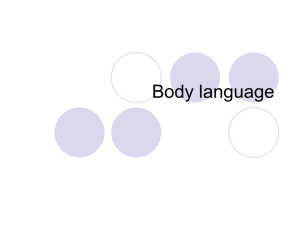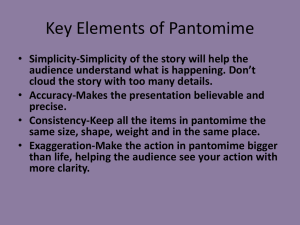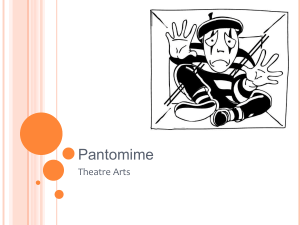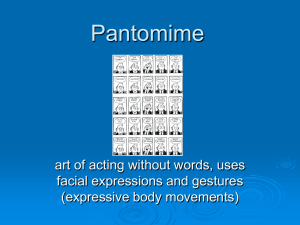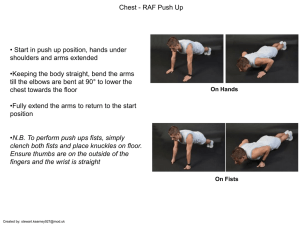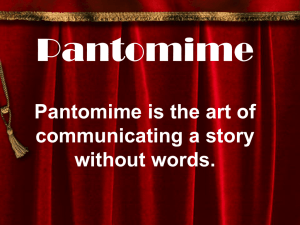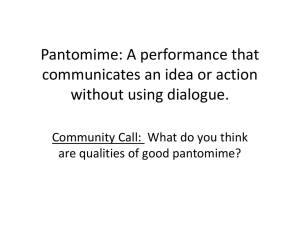Pantomime 2 - Valley View High School
advertisement
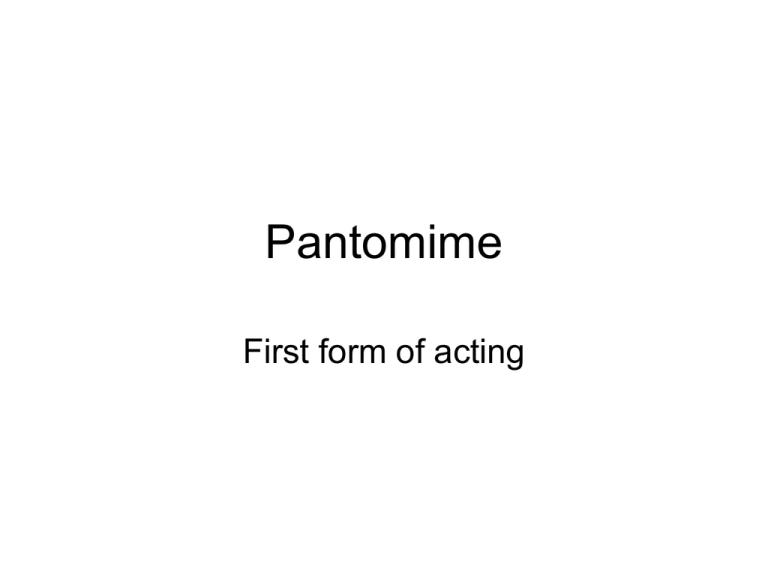
Pantomime First form of acting Vocabulary • • • • • • • • • Pantomime: Nonverbal communication: Cross: Gesture: Kinesthesis Mime Inclination: Rotation: Isolation: Vocabulary • Pantomime: art of acting without words • Nonverbal communication: without words • Cross: the movement of an actor from one location to another onstage • Gesture: the movement of any part of the body to help express an idea. • Kinesthesis: neuro-muscular awareness the body feels in a particular physical position • Mime: both the performer and the performance is the mime; highly stylized art form • Inclination:move each body part one at a time • Rotation:move each body part in smooth circles • Isolation:the process of separating parts of the body for individual development and expression Pantomime • First form of acting • Charlie Chaplin is a master in pantomime • French mime Marcel Marceau: excellent example of the original art • http://www.marceau.org/ • http://www.amrep.org/marceau/ Pantomime Movement • Much of our daily communication is nonverbal • Inexperienced actors tend to use only voice • The first phase of acting is the art of acting without words. • Any exercise that develops physical coordination is valuable in preparation to perform. Valuable Exercises • Whenever possible walk or climb stairs. • They are two of the best forms of exercise. • It is important to move your body as a whole. • From the top of your head to the tip of your toes, you should be expressive. • You are judged by how you look and your manner. • You need to be aware of how you look and your physical manner. • Jogging, dance, and fencing are also valuable exercises that prepare the actor’s body. Differences Shy vs. Confident • Strong-willed and confident • Stands tall • Uses broad, emphatic gestures • Moves with authority and self-assurance • Makes quick, definite movements • Directs actions away from the body Shy • Shy and retiring • Stands timidly, drawn in for protection • Uses small, weak gestures • Moves slowly, with limited motion • Directs actions down and toward the body Relaxation • Inner composure • Mental awareness • Loosen all of the muscles of the body Relaxation Exercises • 1. Head: raise, lower, turn to the right and left, rotate the head • 2. Shoulders: forward and backward • 3. Arms in wide circles forward and backward close to the body and at the shoulder • 4. Rotate the lower arms from the elbow • 5. Hands from the wrist in circles • 6. Lift arms from the wrist from the side and then the front • 7.Shake the hands keeping them to the side. Relaxation cont. • 8. Open and close your fists stretching the fingers apart and together • 9. Five finger exercise: hands together with open palms. Make a fist. Roll each finger back individually. • 9. Cont. Alternate fingers. Start at the thumb and make a wave-like motion to your other thumb. • 10. Waist • 11. Clasp hands and over head rotate to the left and right with your head within your arms Cont • 12. Rotate each leg in circles • 13. Kick your legs as high as possible • 14. Rise on your toes and slowly sink and reverse the process • 15. Rotate each foot at the ankle • 16. Pick up a pencil or marbles with your toes. • 17. Breathing: inhale and exhale slowly Posture • Good posture carries an air of confidence, maturity and success • Poor posture suggests weakness, lack of poise, and insecurity. • Normal posture and movement is the next step. – Stand properly: hold the body erect with the chest high, chin up, back flat, arms slightly bent and legs straight keeping one foot in front of the other with the weight on the balls of your feet. Posture Exercises • Perform these daily to develop good posture – Stand erect with your feet parallel. – Bend forward and let the arms hang – Right hand on the chest and left on the small of the back – Slowly raise the body to an upright position and expand the diaphragm so you feel your hands being pushed apart Exercises cont. – Bring your head to an upright position. Hold your chin perpendicular to your throat. – Drop your arms to your sides. Shift your weight to the ball of one foot and move forward. Keep your chest high, your head erect and the small of your back flat. Walking and Sitting • How to walk onstage – Maintain Good posture – Keep your shoulders square and the chest high – Keep the axis of your body over your feet Think tall. – Think “tall.” • • • • • • • • • • Move straight ahead with the weight on the balls of your feet Walk in a straight line Let your body swing easily from your hips Let your arms swing in easy opposition to your legs Turn by rotating on the balls of your feet, shifting your weight from one foot to another Turn your entire body including your head. Do not turn on your heals. As you turn, do not cross one foot over the other. Avoid plodding or long strides or tiny steps. Do not habitually look at the ground as you walk. Walking Exercises • Imagine you are walking – On a sandy beach on a hot afternoon with a fresh wind blowing – In a large city, looking up at the tall buildings – In a dark forest of tall trees and the wind is howling – Across a platform to receive and award – Onto a stage to audition for a part – Off a stage disappointed about your audition Sitting • Proper way to sit – Without being obvious, locate out of the corner of your eye the chair in which you will sit – Decide the best route to the chair – When you arrive turn so the calf of one leg touches the chair. Then place the other calf against the chair and sit While sitting • Keep your spine at a 90 degree angle to the seat (Characters may deviate from this depending on the character I.e. age, youth, etc.) • Hands should be placed on the arms of the chair or at rest in your lap • Your feet may be crossed at the ankle or one foot placed in front of the other. Exceptions are for character specific actors. • In rising, let your chest lead and not your head. Keep your weight balanced on the balls of your feet, placing one foot slightly forward and using the rear one as a lever in pushing yourself up, once again keeping the axis straight. Crossing, Turning and Falling • Entering the stage: – All turns are made to the front – Lead with the foot farther from the audience • By leading with this foot, you enter with your body facing the audience • Enter stage right: start on the right foot • Enter stage left: start on the left foot How to fall onstage • Divide your body into segments head, torso and arms, hips, thighs and legs and lower each segment to the ground. • Control your body; you should be very close to the ground before you actually “fall.” • Absorb the fall with the soft parts of the body: forearms, thighs and legs Exercises: crossing, turning and falling • Crossing and turning: – Enter stage left, turn and leave – Enter stage right, turn and leave • Falling • • • • Relax and swagger back Sway forward, dropping the hands and arms Pivot slowly and go closer to the floor, sink down Land on the side of your leg. Roll on your hip. Catch your weight on your forearm. • Lower your head to the ground, letting it land on your arm. Gestures • Surprise: Eyes widen. Brows lift. Mouth opens into an O. • Happiness: Eyes squint. Brows lift. Moth curves up, sometimes with lips parting. • Sadness: Eyes narrow and lids drop. Outer brows turns downward. Mouth turns down. Facial muscles sag. • Anger: Eyes narrow. Brows furrow. Moth twists downward. Lips sometimes curl out and down into a sneer. Jaw drops and sets firmly. Gesture Exercises • Walking in a Garden, Pick a flower and smell it. Show what you think of the fragrance. • Select fruit from a tree. React. • Facial expressions – Chef opening a rotten egg. – Child taking nasty medicine – Person catching a whiff of his/her favorite food. Gesture Exercises • You arrive at an airport. You are carrying a suitcase, an umbrella, and magazines. You drop your suitcase, and everything spills out. You try to recover the contents of your suitcase, express agitation with both your facial expressions and body gestures. • You are wearing new shoes when you encounter a muddy patch of ground. You must walk through it. Principles of Pantomime • The techniques of pantomime are based on what human beings do physically in response to emotional stimulation. • There are two phases: – Exercises to relax and free your mind – The creation of characterizations in which feeling prompts a bodily response. – Charlie Chaplin says,” Although I was gifted, I was surprised at rehearsals to find how much I had to learn about technique.” Basic Principles of Body Language 1. Your chest is the key to all action. 2. Your wrists lead most hand gestures. 3. Move elbows away from the body when making gestures. 4. Do not gesture above your head or below your waist unless for specific purposes. 5. Opposite action emphasizes physical action I.e. pull arm back before hitting someone. 6. Arms and hands should curve not straight lines. 7. Positive emotions evidenced by high chest and head. Cont. 8. Negative emotions evidenced by shrunken chest, tense movement, restricted gestures and drawn features. 9. Facial expressions usually precede other physical actions. 10. Whenever possible make gestures with the upstage arm and do not cover your face. 11. Some exaggeration is necessary. 12. Always keep the audience in mind and direct all action to them. 13. All actions must be definite in concept and execution and clearly motivated. Standard Pantomime Expressions • Body As a Whole – Heels tog., weight on both feet and chest and head slightly lifted – confidence, aloofness, indifference or self-control – Weight shifted to the front foot leaning forwardinterest, positive emotions, enthusiasm – Weight shifted to the rear with the head a chest pulled back-deep thought, fear, amazement, negative emotions – Shrunken chest with bowed head and shoulders forward and down represents old age, envy, greed, pain, sorrow Feet and Legs • Feet apart and legs straight-arrogance, strong confidence • Feet apart and legs bent-lack of bodily control, old age, fatigue or intoxication • Tapping a foot-irritation, impatience • Stomping a foot-anger • Twisting a foot-embarrassment • Feet apart, head high and hands or fists on hips-conceit, scorn,contempt Head and Face • Head raised, eyebrows lifted, eyes wide and mouth open-fear horror, joy, surprise • Head raised, eyebrows lifted and mouth drawn down depicts bewilderment • Head down, eyebrows down and mouth set or twisted by biting lips shows worry, meditation or suffering • Raised eyebrows, wide eyes and smiling or open lips- innocence, stupidity, flirtatiousness Fingers and Hands • Pointed finger commands, directs or is #1 • Clenched fists – idea, threatens or demonstrates forced self-control • Palms down – refusal, denial, condemnation, fear, rejection, horror • Palms up-giving, pleading, receiving, requesting,offering sympathy • Palms up with a shrug-I don’t know.
